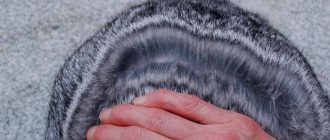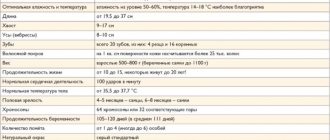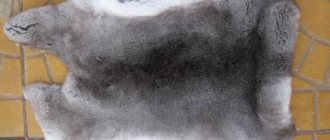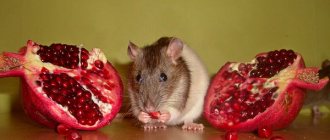Chinchilla big
The large or short-tailed chinchilla is also called the royal or Peruvian chinchilla. The animal is originally from South America, but is no longer found in natural conditions. The short-tailed chinchilla is quite large in size, its body length reaches 40 cm, and its weight can reach up to 900 grams. The rodent is not so popular for keeping at home, but its thick and dense fur has made this animal a valuable game animal; it is bred on special farms. The large chinchilla has only a natural color of gray in all shades.
Puberty
The reproductive system of chinchillas is ready for conception at 4-5 months. However, experienced breeders do not recommend starting mating at such a young age. The fact is that the final development of the body occurs in fluffies only at one year of age. It is at this age that the female will finally get stronger and will be able to bear and give birth to cubs normally.
There are also certain requirements for the age of males. Only boys over 7 months are allowed to groom chinchillas.
Long-tailed chinchilla
The small or long-tailed chinchilla is a popular and cuddly pet. The rodent has a cute appearance, dense and beautiful fur, smart round eyes, a long tail and good health. In nature, the long-tailed chinchilla is extremely rare; the population has sharply decreased due to the illegal extraction of valuable chinchilla fur.
Chinchilla colors
The color variations of the fur of these furry animals are varied and breeders are still working on obtaining new color morphs. A new color is formed as a result of a combination of such components as:
- Fur density
- Pigment,
- Color.
A specific gene is responsible for each of these components, and various combinations of genes make it possible to obtain offspring of a wide variety of colors, even when crossing two animals of the same color. All existing chinchilla colors come from three original colors:
- Black.
- Brown.
- Red.
The complete absence of pigment results in a white color. Genes responsible for a particular shade can manifest themselves differently due to their dominance or recessivity.
Completely white chinchilla
Modern types of chinchillas differ not only in color, but also in the structure of the fur, its density, shine, and softness.
How to plant correctly
The process of boarding chinchillas is a fairly lengthy and labor-intensive task. But since these animals form one pair for life, you will have to be patient and try to ensure that the future parents find a common language.
After purchasing a new male, you will need to send him to a month-long quarantine in another room. This is due to the fact that animals from pet stores and sometimes even from professional nurseries can become carriers of infectious diseases. When the quarantine is over, you can begin to organize the animals getting used to each other. To do this you will need:
- Place the fluffies in 2 separate cages, and place them on the table at a distance of 25-30 cm. This is necessary so that the animals get used to each other’s smell, but cannot bite a potential partner. Also, if the cages are placed too close, the female may release a stream of urine at the male and wet his coat.
- Bathe the male in sand with the addition of dried excrement of the female. This will help him escape from the girl’s aggression.
- Periodically change chinchillas' cages so that they quickly get used to the smell of their future partner.
When the fluffies get used to each other, you can try walking them in the same area. At the same time, the owner must ensure that a fight does not break out. If all the previous stages have been completed successfully, you need to start planting in a cage prepared in advance for mating. To minimize the risk of conflicts, you will need to consider the following points:
- The male should be let into the cage first, and only after 5-6 hours – the female.
- You need to put as much fresh hay on the bottom as possible. Eating grass together will slightly distract the animals from sorting out the relationship.
- Place one bathing suit with sand in the cage for two pets. This way they will acquire a similar smell faster.
- Animals should not be left alone for the first 3-4 hours. Because even with the outward calm of chinchillas, a fight can start at any moment.
- Shelves, ladders and hammocks will need to be removed from the bridal cage. This will protect the rodents from injury during possible fights.
Spending time together and sleeping with the fluffies, active games and “kisses” will indicate that the partners fully accept each other. If everything went well, the formed couple will live together all their lives. But it may also be that the partners are simply not suitable for each other, so they constantly fight or sit in different corners of the cage. In such a situation, it is better to find another boy for the female.
Dwarf chinchillas
The dwarf chinchilla is not a separate breed. This is a genetic mutation, fixed or manifested by chance. The size of the dwarf animal is much smaller than its ordinary counterparts and its weight can reach only 300 grams. Breeding these ornamental rodents is a complex matter. Females often experience difficulty during childbirth, and the offspring have few viable young. Small chinchillas can be found in a wide variety of colors and color morphs.
Estrus
Fertilization of a chinchilla can only occur during estrus. Therefore, it is during this period that it is necessary to take a particularly close look at the behavior of animals.
The first heat in chinchillas can occur at the age of 5-6 months. With early puberty - at 3-4 months. If it’s late – after a year. The frequency of this physiological process may also differ depending on the individual characteristics of the organism.
On average, chinchillas come into heat once every 30-45 days. But sometimes its frequency is reduced to 20 days. Or, conversely, it increases to 2 months.
Readiness for reproduction can be judged by the following manifestations:
- the female's loop swells, turns pink and opens slightly - the appearance of discharge is noted;
- The chinchilla's nipples become red and protruding;
- The male shows strong interest - he makes calling sounds, does not leave the female, and constantly tries to jump on her.
To properly plan conception, you need to know the main stages of the chinchilla cycle:
- Hunting period . It starts from the moment of estrus and lasts 2-3 days. It is at this stage that ovulation occurs - the most successful moment for conception. Externally, this period is accompanied by the opening of the loop and close communication between partners.
- Braking . Sexual hunting subsides, and the animals gradually return to their usual way of life. At this stage, pregnancy can already be diagnosed.
- Balancing . The female's loop closes completely, and the male almost completely loses interest in her.
Successful conception during estrus is indicated by vaginal plugs emerging from the chinchilla's loop after 1-2 days - the male's seminal fluid dried in the form of thin flagella. Stoppers are necessary to protect future babies from infections.
Genetic calculator
Chinchilla genetics is an interesting and rather complex science. A large combination of genes and their combinations, dominant and recessive manifestations can confuse even experienced breeders. Therefore, a special genetic calculator for chinchilla colors was developed. The main genes of the parents are entered into the calculator: white, beige, sapphire, ebony, purple, velvet and angora, as well as the degree of manifestation of the genes:
- Present or not,
- Double or not
- Carrier or not,
- Gene shade (from light to dark).
Based on the data obtained, the calculator calculates not only the genotype of the parent pair, but also all possible colors of the offspring and the probability of obtaining them. The calculator is useful not only for beginning breeders, but also for those who want to breed a new color morph or fix a specific gene. You can find a genetic calculator on numerous websites of chinchilla breeders and large nurseries.
- Types of chinchilla colors
6
Breeding chinchillas
The most difficult part of chinchilla breeding practice is the chinchilla breeding technique. This is due to a number of reasons, in particular the physiological characteristics of these rodents.
Chinchillas reach sexual maturity around the 8th month of life. However, females are often capable of reproduction already 4 months after birth, and sometimes earlier. In rare cases, chinchillas begin to reproduce later - between the ages of one and three years.
Successful breeding of chinchillas is facilitated by strict adherence to the rules of breeding techniques. But we should not forget that the correct selection of individuals into pairs plays an important role, and this should be based not only on the specifics of breeding characteristics, but also on the characteristics of the individual character of the animals.
There are two ways to reproduce chinchillas: paired and polygamous.
The male and female must necessarily have all the noticeable signs of a thoroughbred individual of this species; in addition, both animals must be healthy and have an excellent pedigree.
Pair breeding
. Individuals in a pair are selected based on the similarity of colors and the similarity of quality characteristics of the fur, since these are the leading characteristics. Therefore, to make a pair, you should take animals belonging to the same hereditary branch, but it is not recommended to mate animals that have family ties closer than the third generation, due to the possible deterioration of the litter and the loss of especially valuable qualities in the puppies.
The female brings from one to six puppies 2 times a year and already on the first day after giving birth she can again be fertilized. But this reduces the quality of the offspring; the cubs become weaker each time, which affects their breeding characteristics. Therefore, fur farmers need to ensure that rodents produce offspring only 2 times a year.
Among other indicators, when making a pair, one should keep in mind the age differences between the female and the male, since in a pair formed by a young male and a female more than two years old, productivity decreases in comparison with those cases when the pair is made up of individuals of the same age or when the male older than the female.
But it is impossible to avoid all the difficulties in breeding chinchillas by observing only the listed measures. If these requirements are met, and the couple does not produce offspring or the puppies do not have the most important generic characteristics, a number of measures can be taken to achieve the necessary harmony between the animals.
The premises intended for animals must be well ventilated and kept clean. It is necessary to establish a permanent ventilation system in it, as well as maintain an optimal temperature of 16–20 ° C. Compliance with these basic conditions for keeping chinchillas will ensure the desired results of their reproduction.
It is necessary to take into account that if an animal lived alone in a cage for a long time, then this leaves its mark on its behavior: a certain instinct appears to protect its own space, even from individuals of the opposite sex. Therefore, it is better to let the more active female approach the male first.
A cell divided by a septum
First of all, you should place them in one cage with a partition for several days. The fact is that female chinchillas are often stronger and larger than males, as well as more aggressive, and the partition will protect the male in case the female tries to show her displeasure. In such circumstances, you need to disturb the chinchillas as little as possible, create the best conditions for them, but leaving them unattended is not recommended. During this period, they need careful observation and careful attention more than ever.
If your efforts are unsuccessful and the relationship in such a pair does not go well, it is better to try to create other pairs with the same male and female.
The physical condition of the reproductive individuals is important for achieving success during reproduction: obesity or exhaustion often leads to the appearance of weakened or completely unfit offspring, which will either die or affect the quality characteristics of the herd. In addition, there is a possibility of females becoming unmarried, which also adversely affects the breeding work of the fur farmer.
The approaching breeding season in chinchillas can be determined primarily by the so-called female biological clock. This is due to the fact that, starting from the moment of puberty, its readiness for reproduction manifests itself with a certain cyclicity: several times a year, approximately every 41 days (depending on individual characteristics - 30–50 days). These periods last from two to seven days, ending in pregnancy if mating is successful. Much depends on the time of year, as well as on the climatic conditions of the area in which the animals live. Thus, the moments of greatest sexual activity in chinchillas occur from November to May.
It is not uncommon for young animals placed in the same cage to live together until old age (the life expectancy of rodents is 16-18 years). Moreover, such pairs can be used for breeding for up to 10 years.
A novice fur farmer can determine when chinchillas are ready to mate by some external signs and the changed behavior of the animals. If under normal conditions during the day they behave calmly and most often sleep, then at this time their daytime activity increases, they become more active, and the male’s courtship takes on a pronounced character: he runs after the female around the cage and snorts quite loudly; The female has a lack of appetite (she may even periodically ruin the feeder).
Such changes in the behavior of animals are accompanied by changes in the external genital organs: they increase somewhat in size and become pinkish. At the same time, the male’s genital organ becomes more visible, which is separated from the anus by a rather large gap; and in the female, the genital slit opens, located quite close to the anus.
A fur breeder very rarely manages to observe the mating process itself, but it is necessary to record the day on which it occurred. This is facilitated by a thorough inspection of the cell taken under special control, performed by the owner every morning. One of the main indicators indicating mating is a waxy vaginal oblong flagellum (approximately 2.5–3 cm long), which is formed during mating in the female’s vagina and is called the vaginal plug. If its secondary discharge is observed in a female considered pregnant, the gestational age is calculated from the time the second plug is detected.
Sometimes the listed signs are absent, and in such cases the fur farmer will be helped by his attentive attitude to working with breeding chinchillas. The fact that a female is pregnant can be determined by changes in her weight. Weight measurement must be carried out at least once every 10 days, and both animals must undergo this procedure (weighing the male will provide material for comparison).
When the gestation period approaches the end, the female chinchilla usually gains 40-70 g in weight. But do not worry if her weight has increased to 100, and sometimes up to 140 g - this may indicate the number of cubs in the litter, as well as their sizes.
During the first two months there will be no significant weight gain, which is due to the slow development of the fetus. At this time, to determine the weight of the female, you should use special scales with high sensitivity - scales for newborns.
The third month is accompanied by a noticeable increase in the female’s weight, as the embryo begins rapid growth.
Determining the fact of pregnancy using X-ray equipment is possible when the fetal skeleton hardens enough to be visible in the image - at the end of the entire pregnancy.
In any case, pregnancy for a period of 2–2.5 months is easy to determine by the appearance of the animal: the female looks fairly plump, her belly is clearly enlarged and her nipples are swollen.
Polygamous reproduction
. This method of reproduction, when several females are fertilized by one male, has its positive aspects. Firstly, the maintenance of animals will require much less feed resources. Secondly, it is possible to select males according to higher criteria, which is associated with the principle of polygamy, when there are several females for one male, and this increases the level of breeding work. Thirdly, the polygamous method of breeding chinchillas plays an important role in the selection of skins for the fur industry, as it allows for greater color uniformity and better fur quality.
A chinchilla family usually consists of a male and 5–8 females, with each female living in a separate cage. Thus, a common large cell includes 5–6 (or more) small ones. The females' cages are located along a small corridor of a common cage approximately 20 cm wide. At the same time, a special plastic collar with a diameter of 10 cm on the female's neck does not allow her to leave her cage, the diameter of the entrance hole of which is only 7 cm.
Such conditions allow the male to move freely from his cage to any other. Moreover, if the female is not inclined to communicate with him or is too aggressive, the male can calmly retreat without fear of persecution, since her collar prevents the female from leaving the cage, sometimes thus saving the male’s life.
It is necessary to treat young animals with care when starting reproduction for the first time. The number of females for each 9-month-old male should not exceed two to four. Later this number can be increased to 4–8 females.
After the copulation period, in order to avoid significant weight loss (up to a fifth of normal weight), males are transferred to increased nutrition.
Chinchillas usually mate at night. After 12 hours, the congealed seminal fluid in the form of a plug comes out of the vagina, and if the female’s next estrus does not begin after 30 days, this most likely indicates that the female is pregnant.
With polygamous reproduction, the adaptation period of the animals is important, during which they gradually get used to each other. These days there is no need to close the females' cages, although the male may not immediately muster the courage to enter. This is especially important for young males.
The duration of pregnancy in Chinchilla lanigera is on average 111 days, and in Chinchilla brevicaudata - 125, the duration of gestation is 105–115 days. The last few weeks before giving birth, females need careful handling and careful care. At this time, under no circumstances should they be weighed or picked up. They need rest, otherwise the offspring may appear prematurely, weak, with any abnormalities, or dead, which is due to the particular timidity of females before childbirth.
During pregnancy, the female should be provided with improved nutrition, characterized by greater variety and a rich content of vitamins. As a supplement to the diet, you can use milk and specialized foods containing vitamins necessary for a pregnant female.
The most troublesome time for a fur farmer is the time before birth, birth and the first days of life of puppies.
Approximately 10 days before the expected birth, a nest box with an area of 20 x 30 cm and a height of up to 30 cm, insulated with straw and hay, is turned over so that the hole is on top. This is done to prevent the female from scattering the straw. A few days before birth, the sand bath should be removed from the nest.
Immediately before giving birth, the female must be provided with complete rest. At this time, you need to make sure that there is always fresh water and succulent food (grass, carrots and apples) in her cage.
Due to the fact that as the time of birth approaches, the female's anxiety increases, there is a danger of sudden aggression towards her partner, despite the fact that under normal conditions they lived in complete harmony. If this is observed or suspected in connection with the aggressiveness usually inherent in the female, it is recommended to temporarily separate the male: make a partition in the cage or transplant him into another cage. This guarantees the absence of additional irritation for the female and the safety of the male.
The activity of the female, sensing the imminent onset of labor, is greatly reduced, she stops eating, and movements almost completely stop. She is disturbed by any extraneous noise, she is suspicious of all human actions. A female in this state is very dangerous, especially for the offspring about to be born: she can kill and eat her cubs. To avoid this, you need to cover the cell with dark matter. In addition, the attitude towards the female should become even more careful and caring.
Immediately before giving birth, the chinchilla's loop increases in size, sweat often appears on the nose, and cloudy fluid may appear from the genitals.
Childbirth in a chinchilla lasts from several minutes to several hours, which is associated with the number of puppies in the litter, as well as with the age and general condition of the mother herself. After giving birth, the female eats the placenta and begins to care for the puppies.
It should be borne in mind that childbirth does not always go smoothly, and human assistance may be required, so it is especially important to begin the morning inspection of the cells with the one in which the birth is expected (childbirth usually takes place at 5–8 a.m.), so that, if necessary, provide timely assistance.
If the birth is not going well, it is better to consult a veterinarian for help, and before the veterinarian appears, give the female a drink of thick sugar syrup, which is easily digestible and has a stimulating effect on the muscles of the uterus.
Puppies are born at intervals ranging from a few minutes to 1–2 hours. Newborn chinchillas weigh 30–70 g, depending on their number in the litter (for comparison: by 12–15 months, when chinchilla growth ends, the weight of the animals reaches 500 g), the body length of the babies is 6–7 cm. They already have teeth, vision is developed, and a small downy covering resembles future wool and performs the same function of protection from the cold. If the puppies' eyes are closed or inflamed, they should be washed with boiled water or a 2% solution of boric acid.
Sugar is better absorbed dissolved in water, but it can also be given in dry form, at least 3-4 times a day. A thick aqueous solution is given in 2-3 g doses, and granulated sugar – in 1.5-2 g doses. In addition, you can add a 0.1% solution of sinestrol.
If a female gives birth to more than two cubs, it is recommended to ensure that they all receive a sufficient amount of milk, since the stronger ones may push away the weaker ones, not allowing them to eat. Sometimes this leads to frequent fights between puppies, which indicates a lack of food.
In such cases, you need to feed the babies using a sterile disposable syringe or plastic bottle. It is not recommended to use glass pipettes when artificial feeding, as puppies with sharp teeth can bite through the glass and may get injured. To feed puppies, use a mixture of condensed milk and chamomile infusion (in a ratio of 1: 2), which is heated in a steam bath to room temperature. Babies are first fed a little every 2 hours, then the breaks are increased to 4 hours and eventually to 6. In this case, the mixture is poured very carefully, in order to avoid death from aspiration pneumonia, that is, caused by the baby choking.
From the very first minutes after birth, there are many different dangers that await puppies. And the main one is that their birth can occur not in a warm box prepared for this event, but on the cold floor of a large cage. In this case, babies may catch a cold, especially if the room is cool. Since the chinchilla does not carry its cubs in its teeth, like other animals, the fur farmer must come to the aid of his newborn pets and, first of all, wrap them in cotton wool so that they dry out, and then provide the necessary conditions. If the puppies have been in the cold for a long time, they should be given artificial respiration and given a small amount of 40% glucose solution to drink, and then placed in a box specially designed for them, where their mother is waiting for them.
If chinchillas are reluctant to drink a prepared formula that contains only condensed milk, you should try using a different type of milk. Chamomile infusion can be replaced with regular boiled water.
One-day-old babies are not helpless: within a few minutes they begin to move independently and get acquainted with the outside world around them. It is quite clear that this can have different consequences, so many experienced fur farmers recommend keeping the box with the hole facing up at this time.
Chinchillas differ from other rodents in being less fertile. It is considered to be a good result if, at home, a female brings 2 puppies a year. It is also necessary to keep in mind the fact that in the litter of a young chinchilla there are always fewer puppies (1-2) than the older female brings (sometimes the number of pups reaches 7-8).
One-day-old animals, when they dry, need to be registered: determine the weight, body length and sex. Most often, the content of males and females in one litter is determined by the ratio of 60: 40%, respectively. But such characteristics as body weight, its size and the possible activity of babies are directly related to such parental properties and to the characteristics of the entire herd.
The main factor influencing the physical condition and development of chinchillas is the mother’s milk supply, since in the first days of their life the babies feed only on her milk. Females have 3 pairs of mammary glands, of which only the upper 2 are functional (in most cases milk does not reach the lower nipples). But for 2–3 puppies this amount of milk is considered sufficient.
It happens that the female does not begin lactation immediately. Sometimes milk appears only after 3 days. To avoid the negative consequences of such a delay, you should monitor the appearance and behavior of the puppies: if they do not receive milk, their activity decreases, they become lethargic, incurious, lose the enthusiasm inherent in young animals, stop moving, and keep their tails down. These signs indicate a lack of milk in the female. In this case, the fur farmer needs to take action, since sometimes it happens that, not understanding the reason for this state of affairs, the puppies bring the mother to an aggressive state, in which she can even punish them for pestering them by biting them hard. The female is examined, and if necessary, the puppies are transferred to artificial feeding or transferred to a cage with another female who has a lot of milk.
When artificial feeding, sanitary and hygienic rules must be observed: first of all, it is necessary to assign a separate drinking bowl and pipette to a certain litter and boil them before each use.
Feeding a puppy with a pipette
Feeding for the first 7 days is carried out using a plastic pipette quite often, with an interval of 2.5–3 hours. The required amount of mixture per feeding is initially half a pipette, then, due to the growing needs of babies, it can reach several full pipettes. It is recommended to gradually teach puppies to eat from a designated bowl, while increasing the time gap between subsequent feedings.
Puppies should be weighed regularly as continued weight gain is an indication of normal nutrition. On average, the weight of 2-week-old chinchillas should be 80 g, and month-old individuals weigh about 120 g.
If puppies are already accustomed to artificial feeding, then no food restrictions should be made, since biological needs will not allow animals to eat more than their body needs.
Lactating females require increased attention. It is necessary to regularly monitor the condition of the mammary glands, since puppies can injure them when feeding. If damage is detected, it is recommended to lubricate the inflamed nipples with camphor alcohol or oil.
If the mother has too much milk, the excess must be expressed from the third pair of nipples. After this, the nipples are lubricated with Vaseline or compresses are applied to them.
Caring for and raising young animals does not require much effort from the fur farmer if there are no problems with milk and the female perfectly fulfills her duties in relation to the offspring. The only thing that needs to be done constantly is an examination of the puppies, which allows you to record deviations from the norm in their physical condition and behavior and take timely measures to prevent negative consequences. Particularly careful examination should be carried out in the first 6–8 weeks from the moment of birth, observing first of all the general condition and level of development of the chinchillas.
A healthy puppy without any abnormalities is quite mobile. He is very dexterous and mischievous, loves to play with his peers, using various objects for play, for example, circles cut out of the bark of any tree, which can be placed in the cage so that the puppies will grind their teeth on them.
Already a few days after birth, chinchillas need to be given the opportunity to move freely around the cage, for which the nest box is returned to its original position so that the entrance hole is on the side.
Grown-up puppies can be fed the same foods as adults, but more carefully selected for the presence of vitamins and nutrients necessary for growth and development, and have a positive effect on digestion.
Puppies react warily to the appearance of a stranger, hide in the farthest corners or seek refuge from their mother, and sometimes make alarming sounds. Therefore, it is not recommended to disturb chinchillas with any external stimuli unless absolutely necessary, one of which is the appearance of a person unfamiliar to them in the room where the cage is located.
A week after birth, along with milk, you can introduce a small amount of crackers or granules into their diet, and after 2 weeks - hay. You can stop breastfeeding at the 5th week of a baby’s life.
Concentrated feed (cereals) are crushed before consumption.
If puppies begin to have diarrhea when switching to solid food, you need to exclude milk from the diet and instead give a concentrated chamomile infusion. In addition, you can use any medicinal children's syrup (4 drops for each puppy in the morning and evening).
Particular care must be taken with regard to green food: it should be introduced to it gradually, first mixing it with hay. Legumes, such as clover, are the worst for babies to digest, so it is better to introduce them into the diet of adult chinchillas.
The lactation period for chinchillas lasts 45–60 days, so it is recommended to wean puppies from their mother between the 50th and 60th day from birth, when they are already physically developed and independent. After jigging, you need to continue feeding the young animals with warm boiled milk. It is possible to wean puppies from their mother at one month of age, since boiled milk does not have a negative effect on their body. Such early jigging has a beneficial effect on the female and contributes to the subsequent production of stronger and healthier offspring from her. This is also reflected in the breeding properties of chinchillas, such as the speed of growth and development of puppies.
The growth rate of chinchillas is quite high: in the first month of life they increase in size by 3 times compared to newborn babies. Nine-month-old individuals are already considered adults.
It is necessary to strictly monitor the process of puppies growing up, correlating height and weight indicators, and in case of significant deviations from the norm, determine their causes, paying attention to the chinchillas’ nutrition and behavioral characteristics. It is recommended that the less strong and developed of them be separated from their mothers a little later, and after separation be provided with adequate nutrition and placed in separate cages, while healthy young animals are kept under normal conditions: males and females are placed several individuals in each cage, separating them by gender .
Types of chinchilla colors
At home, chinchillas are mainly bred in the following colors: standard gray, black velvet, white, beige, homobeige, ebony, purple, sapphire. When these colors are crossed with each other, more than 200 different combinations of hybrids arise, some of them have a complex genetic structure and are developed in several stages.
Standard gray
– wild natural color, carrying two recessive genes – aa. Crossing parents of similar colors produces similar offspring. Among standard gray chinchillas, light standard, medium standard and dark standard are distinguished, since the color of the fur can vary from light gray to dark gray with a bluish tint on the back and sides and from white to bluish-white on the abdomen. On the curves of the body you can observe a play of tones, since the lower part of the hair is black or bluish, the middle part is white, and the upper part is black.
Black velvet.
The color was first developed in 1960 in the USA.
Distinctive features of this color are black diagonal stripes on the front legs, black back and head, and white belly.
Black velvet
Chinchillas of this color cannot be crossed with each other, as they have a “lethal gene”, which negatively affects the quality of the offspring.
Crossing with other colors produces the following main types of hybrids: white velvet (with Wilson's white); brown velvet (with heterobeige); purple velvet (with purple in two stages); sapphire velvet (with sapphire in two stages), etc.
Wilson's white, mosaic (or white velvet), silver.
This color, first obtained in 1955 in the USA, is dominant and contains a “lethal gene”. The appearance of heterozygous individuals is different, the fur color ranges from snow-white to dark silver.
White chinchillas are carriers of a recessive “lethal gene” that appears as a result of crossing two white parents. Therefore, animals that are carriers of this gene are not crossed with each other.
Recessiveness is a form of relationship between two genes in which one of them has a less strong influence on the corresponding characteristics of an individual than the other.
In relation to the standard gray, the white gene is dominant, and as a result of crossing, both white and standard animals are born.
White velvet color can be obtained by crossing black velvet and white Wilson. As a result, the individual receives white, black velvet and standard genes. White velvet, which has the effect of double dominance, is characterized by white fur, a dark “mask” on the head, and dark gray diagonal stripes on the front legs.
You should avoid crossing white velvet with animals of the following colors: white velvet, black velvet, brown velvet, purple velvet, sapphire velvet, as well as white, white-pink, white ebony. This is due to the fact that white velvet carries two “lethal genes”, characteristic of white Wilson and black velvet.
Beige
the color was first obtained in 1955. Animals in which beige is the dominant color have pink to dark red eyes and pink ears, sometimes with black dots. Fur color varies from light to dark beige.
Dominance is a form of relationship between paired genes, in which one of them has a stronger influence on the corresponding characteristics of an individual than the other.
Beige chinchillas are homozygous, so they interbreed well with others. The result is wonderful hybrids.
Beige homozygous.
Animals of this color do not have the “lethal gene” and can be homozygous. Beige homozygous chinchillas are distinguished by light cream fur with a pinkish tint, pink ears, light pink pupils with a light blue or white circle around the pupil.
Beige color
As a result of crossing a homobeige animal with a standard one, heterobeige puppies are born. When heterobeiges are crossed with each other - hetero- and homobeige individuals, the most successful pairs for which are white-pink, brown velvet, white velvet, velvet heteroebony, velvet homoebony.
Heterozygous beige.
The combination of two heterozygous beige chinchillas produces 25% homozygous beige, 50% heterozygous beige, 25% gray animals.
Crossing a heterozygous beige and a standard gray will produce an equal number of heterozygous beige and standard gray chinchillas.
Brown velvet
obtained by crossing the colors black velvet and beige. Hybrids of this species have a white belly and back - from light to dark shade. To prevent the number of cubs in the litter from decreasing, it is not recommended to crossbreed animals with the black velvet gene.
White-pink
obtained by crossing beige and white chinchillas with beige, white and standard genes.
Due to double dominance, there is the possibility of the expression of beige and white genes. The ears of such animals are pink with black dots, the eyes are from pink to dark ruby, and the fur is white. The presence of brown spots of various shapes and locations is allowed.
Fur breeders do not recommend crossing pink and white individuals with each other due to the presence of the white Wilson gene, which has a lethal factor.
Homoebony
. Color has not yet been thoroughly studied. Chinchillas of this color are distinguished by a beautiful shine and particularly silky fur. However, breeding such animals is quite a difficult task, since homoebony grows slower and is smaller in size compared to other hybrids.
Homoebony
Heteroebony.
The genotype of animals of this color contains standard and ebony genes. Obtaining a dark heteroebony chinchilla is possible by crossing a male of a similar color with a light standard female.
The resulting individuals can be light, medium, dark, very dark. Crossing with a beige animal results in the appearance of a pastel color. Heteroebony is the result of crossing homoebony and standard chinchilla, homoebony and heteroebony, heteroebony and standard, heteroebony with each other.
Velvet ebony.
Velvet ebony are hybrids of black velvet, homoebony and heteroebony, having the genes of black velvet, standard and ebony.
The presence of the velvet gene in heteroebony is determined by the dark color of the back and the “mask” on the head. Velvet homoebony is distinguished by light fur on the sides and dark colored fur. The diagonal black stripes on the paws are not visible. The black coloration of the belly indicates the presence of the ebony gene.
Velvet heteroebony is obtained by crossing heteroebony with black velvet, velvet homoebony - by combining velvet heteroebony with homoebony or heteroebony. These individuals have shiny fur, close in decorativeness to the color of homoebony. However, it is undesirable to cross velvet chinchillas with each other due to the presence of a “lethal gene”.
Violet
color related to recessive mutations appears only in the homozygous state. The result of crossing with standard chinchillas are standard animals that carry the purple gene, which is not manifested externally. The fur color of such animals varies from light to dark lilac. The abdomen is snow-white in color.
Purple color
This color is quite rare, since purple chinchillas begin to reproduce only at 14–18 months. But despite the difficulties that fur farmers face when breeding, these hybrids occupy the second most popular place in European countries after animals carrying ebony genes.
Experts recommend crossing a purple chinchilla with a standard purple chinchilla so that the quality of the fur does not deteriorate.
Purple velvet
. A hybrid of black velvet, homoviolet, having the gene for black velvet, standard and purple. The animal's fur is dark lilac, its belly is white, and diagonal dark stripes are located on its paws. The black velvet gene affects the base purple color, making it darker.
The hybrid is bred in two stages: by combining black velvet and purple chinchillas, animals with the black velvet genotype are obtained - a carrier of purple, which are then crossed with purple. The resulting puppies can have different colors, one of which is ultraviolet.
Sapphire.
The sapphire color is recessive. When crossed with a standard chinchilla, puppies are obtained that are standard carriers of sapphire, which does not appear externally. The combination of two sapphires or one sapphire and a sapphire carrier results in sapphire animals. The color of the fur remains the same throughout the animal's life.
In 1967, the first purple chinchilla appeared in Zimbabwe. Her cubs were purchased in 1975 by a Californian fur breeder, who began breeding animals of this color.
Table of contents
Cage equipment
Before buying an animal, you first need to take care of the house - a cage for the chinchilla. Basic requirements for arrangement:
- The height of the cage should be large. For example, dimensions 50x50x are suitable. It is imperative to have at least two levels along which you can move using ladders. The cage should be designed approximately as if a ferret lived in it - large and with holes.
- Locks, latches and latches must be strong so that a nimble animal cannot accidentally open them and escape.
- It is important to place the cage in a cool place, but without drafts. The room should not be with high humidity. The temperature needs to be stable, without jumps.
- The bottom is lined with sawdust. Teaching a chinchilla to go to the toilet in one place is almost impossible, so the sawdust needs to be cleaned frequently.
- It is advisable to buy a feeder and a bowl of water so that they can be hung or securely fixed. This will prevent contamination because chinchillas easily knock over bowls.
- For active games you need shelves and a wheel.
- For relaxation, a house is useful - a kind of mink.
- Chinchillas need to grind their teeth, for this purpose mineral premixes and limestone stones are placed in the cage.
Pairing
Chinchillas are nocturnal animals. Therefore, their mating process usually occurs at night. With the onset of estrus, the boy shows active courtship towards the female. And when she succumbs to his charms, he jumps on her, biting the fur on her back. After which the actual sexual intercourse occurs. It does not last long - only a few seconds.
Not every owner will sit in front of the cage all night long to make sure the event is successful. In addition, this will greatly stress the animals. The fact that everything went well for them can be judged in the morning by the fur and dried sperm of the male scattered throughout the cage.
Keeping at home
Keeping a chinchilla at home does not pose any great difficulties. The only thing that can be a problem is ensuring a comfortable temperature regime. Chinchillas cannot tolerate heat at all: temperatures above 25 °C cause overheating, and above 30 °C can cause death.
Chinchilla lives a long time - up to 20 years. Therefore, when deciding whether to buy it, it is important to think carefully.
Animals are active at night, so you should not place the cage in the bedroom.
The conditions of keeping a chinchilla require constant monitoring of cleanliness. Insufficient cleaning is one of the main causes of health problems.
Caring for a chinchilla involves bathing, but the animals clean their fur not in water, but in sand, like some other rodents, such as degus. For sand baths, you need to prepare a tank with high walls. Chinchillas need special sand – zeolite.
The main beauty - the fur - usually does not require special manual care, which distinguishes the chinchilla from other furry pets, for example, the Dutch lop-eared rabbit.








